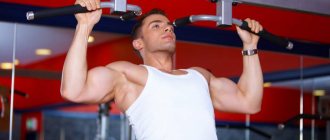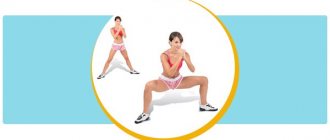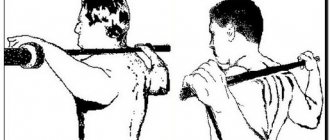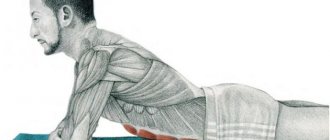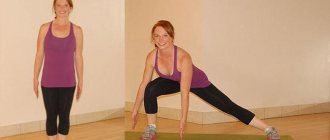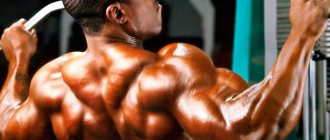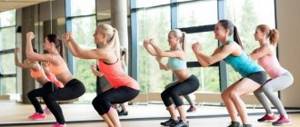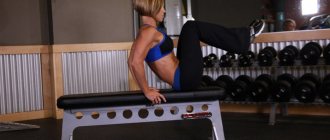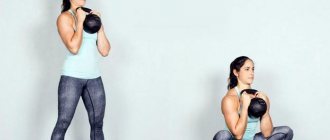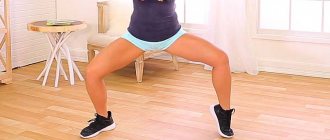Publication date: December 24, 2021.
Front squats are a variation of squats with a barbell on the shoulders. Unlike classic squats, here the bar rests on the front of the shoulders, that is, it is in front of the head, and not behind it.
This exercise is quite difficult and therefore ignored by many athletes, but such a fate is completely undeserved.
Front squats can increase strength in regular squats (and therefore will be beneficial for powerlifters).
They are also able to push the leg muscles to active growth and diversify the load on the stabilizers, which bodybuilders cannot but appreciate.
This exercise has great general development potential, significantly increasing the overall strength and endurance of the body, and therefore athletes of all possible disciplines can include it in their training process.
Wrestlers and track and field athletes should pay special attention to it. It is also distinguished by greater safety of execution; if difficulties arise, it is much easier to lose weight from the chest than from the shoulder blades, and the working weights of front squats are much less.
Benefits of Exercise
A distinctive feature of this type of squats is the location of the bar, which is unusual for many athletes. Unlike the more standard version, the barbell is placed on the chest and deltoids, and not on the back muscles at all.
This variation results in the back being in an almost vertical position, which radically changes the load on the body. And the muscles that are involved in the work change radically.
What muscles work:
- The main work is done by muscle units such as quadriceps.
- The auxiliary muscles are the gluteus maximus, gastrocnemius, soleus, posterior thigh muscles, as well as the rectus and oblique abdominal muscles.
Thus, there are a huge number of advantages in using this type of squats:
- An undeniable help in building well-developed thighs, a strong lower back and strong abs.
- Reducing the compressive effect on the spinal column, and therefore on the entire back, minimizing knee injury.
- Lack of lumbar torque.
- There is a high probability of performing the exercise with the correct technique. Otherwise, the barbell will immediately fall to the floor and you won’t be able to squat. And mastering the correct technique is crucial in any athlete’s training cycle.
- Formation of impressive core muscles, development of more reliable stability.
- If a plateau occurs when training your legs, it easily eliminates this problem, literally exploding muscle growth.
- Promoting better fat burning.
Who needs front squats?
As already noted, these exercises are the most effective for pumping up the buttocks and hamstrings, but it cannot be said that if you want to improve the muscles of these parts of the body, then front squats are a must-have in your training program. If you are a beginner and have recently started working with weights, then you should start with classic squats to learn how to maintain balance and understand the technique of performing the exercises. If you have enough experience, such exercises can become one of the basic ones in your training, but only if the buttocks are your problem area.
Working weight exercise
Considering that this exercise is basic, it does not tolerate weak or lagging muscles. This means that if you want to increase the weight of the projectile, all the shortcomings of the technique can come out due to lagging links in the form of individual muscle groups.
Therefore, the weight on the bar will be 25%, and maybe even 50% less than in classic squats.
It depends on whether you performed a full descent to the bottom point or not. For example, if your weight was 100 kg in the classical form, and you squat below parallel, the barbell weight on the chest could be 85 kg. If not, it’s better to take 50 kg.
This huge difference is due to the fact that with regular squats the amplitude is partial. There is nothing terrible or shameful in this; work progress will not slow down. After all, better hip development will be achieved while minimizing injury. The barbell squat improves glute activation and allows for greater squat depth.
Squats without dumbbells - preparation
If you are an absolute beginner in squats with weights, then at first it is recommended to perform regular squats, without any weight in your hands (shoulders or behind your back), using the same technique as when doing squats with dumbbells. To feel the working muscles and establish a neuromuscular connection between the brain and muscles. After all, the main thing is not the weight, but learning the correct exercise technique.
Perform the exercise carefully, do not jerk, both when lowering and when standing up, so as not to harm your knee joints, and in particular the meniscus. Gradually, after a few weeks of training, you can pick up light dumbbells.
How to do a front squat?
The most important condition for performing any kind of exercise is not its aesthetic beauty, not the record weight you lift, but the correct technique.
In order to master squats with a barbell located on the chest, you need to gradually perform the following steps:
- Use a power rack. To do this, approach it and make the height of the racks convenient for you personally. The classic option is at the height of your own shoulders. Next, place the barbell on the racks and place the required number of weights.
- Step forward with one foot and tuck your shoulders under the bar. After crossing your arms, place them on the top area of the barbell. The location of the elbows must be strictly parallel to the floor. After removing the bar, take the reverse step.
- The initial position of the feet is shoulder-width apart, the toes turned 30-35 degrees. The abdominal muscles remain tense. This is the position from which the exercise starts.
- Before squatting, be sure to straighten your back and place your feet firmly on the floor. Next, slowly, while inhaling, begin squatting until your thighs are parallel to the floor. If you get a deep squat without compromising your technique, do it. The gaze is directed in the direction of movement.
- After pushing hard through your heels, straighten your legs and return to the starting position. Perform the specified sequence as many times as necessary.
In addition to the classic version of the squat with a free weight in the form of a barbell, there may be the following options:
- Using dumbbells or weights. This is an excellent option for girls who are interested in adjusting their legs, rather than intensive mass gain, and beginners who are just mastering technique and a sense of balance.
- Using a Smith machine. The principle of performing the exercises is the same as with free weights. However, Smith squats provide additional control and safety.
Front squat with dumbbells
This squat is much better than the classic squat for several reasons:
- – involves the largest number of core muscles;
- – this method allows you to squat much below parallel;
- – with this squat, the weight is better regulated.
There are several techniques for front squatting with dumbbells.
- You need to sit down as low as possible, you must not lift your heels off the floor and your back must be straight, you must bend your arms at the elbows and let the dumbbells touch your chest, you must create a load on your arms while holding the dumbbells suspended, you must place the dumbbells on the upper chest, holding them with your hands.
- The second option is similar to the first, the only difference is that the dumbbells should not be placed on the chest, but held on outstretched arms. The most important thing is to keep your back straight, otherwise your back may round.
There is also a third option for squats with dumbbells with a wide stance.
The essence of the exercise is that the legs should be placed wider than the shoulders, and the dumbbell should be held at outstretched arms. The rest is done exactly the same as in the first two options.
For the exercise of the previous option, you need one dumbbell and its weight should correspond to what you can hold.
The advantage of such exercises is stretching of all muscle groups involved.
Variations
Depending on which muscles you want to pump with front squats, you can perform different variations. For example, if you take not a barbell, but other weights or position your legs differently, the load will be distributed differently than in a classic exercise.
- In Smith
Smith front squats are much easier to perform than the classic exercise. In addition, they guarantee greater safety for the back and knees. The barbell is placed on crossed arms. Elbows are parallel to the floor. Feet are placed at shoulder level, toes turned out at approximately 45°. Everything else is strictly classic.
- With dumbbells
Recommended for girls who most often have no need for muscle growth, but want to make their legs slimmer and their buttocks more attractive. And the weight is light, and the exercise is easy to perform. Simply take a dumbbell of the required weight in each hand, raise your arms to your shoulders and start squatting.
- With fingerboard
Another option for women is an exercise with a barbell that is not burdened with weights. Makes it easier to master the classical technique and does not cause as much muscle gain.
- With a weight
Front squats with kettlebells are recommended for experienced athletes who already know how to handle this equipment, that is, they can press it well from the shoulder a sufficient number of times. The result is not building muscle mass, but polishing the relief of the legs. One of the obvious advantages is that you can perform the exercise with the same weight an infinite number of times. If you do it with a weight (one), it should be located at the chest, if with two, they are held with your hands straightened at the shoulder joint. The correct technique of execution is that the projectile rests on the upper point of the biceps and the anterior delta.
- Wide / narrow
These exercises can be performed with a wide stance (the so-called “sumo”) or a narrow one. In the first case, the feet are placed far from each other, the toes are turned to the sides. This position allows you to hold larger weights than in the classic outcome. The inner thigh and buttocks are mainly trained. If your feet are placed together, the main load will shift to the quadriceps.
- Depending on the grip
As practice shows, the grip in front squats can be different. Firstly, you can hold the barbell by placing your hands in a cross on top of each other (overlapping) - this is a classic of the genre. Secondly, you can put your elbows forward and hold the barbell with a reverse grip. However, this position puts too much stress on the hands, and intense training can result in injury. Thirdly, weights and dumbbells are taken with a direct grip on the chest.
So front squats are different, and it’s up to you which ones will become the basis of training to pump up this or that muscle group.
Single leg front squat
One of the best variations of barbell squats is the scissor squat and single-leg lunge.
To perform these exercises, good coordination of movements is required. It is not recommended to immediately move on to the barbell. It is best to start doing such exercises with dumbbells, or with minimal load on the body.
The difference between scissor squats and lunges is that when lunging, you need to take a step forward and maintain balance with a straight back.
When using the scissor squat technique, you need to stand as straight as possible, holding the barbell on your shoulders. You need to take a step forward, touching the floor with one knee. Next, pushing off with the heel of the front leg and the toe of the back leg, we take the starting position.
After each approach, you need to take a break so that your breathing is restored and you can begin a new set of exercises.
Squats to lunges are similar, the only difference is that you need to take a step forward and return to the original position.
Sumo technique with weights
For girls, this squat makes it possible to adjust their figure to acquire a beautiful shape of the buttocks and hips.
- Feet wide apart, back straight, take one dumbbell with both hands and place it in front of you.
- Squat slowly, your thighs should be parallel to the floor, your back should remain straight, and your heels should not be lifted off the floor.
- Pause for two seconds and rise to the starting position.
Should I choose a front squat or a regular squat?
People who are just starting to train with dumbbells and barbells have a question: is it better to choose a front squat or a regular one?
For beginners, it is best to start with a regular squat and gradually move up to weights and front squats. However, many coaches believe that the second option is the best for several reasons:
1) Firstly, more muscle groups are involved, and all muscles are tensed equally. On the other hand, the front squat can be difficult for people who have back problems or are unable to lift weights.
2) The front squat improves back posture. The fact is that the weight of the bar allows you to keep your back in a level position and squat so that your back is always straight. Moreover, you must also get up to the starting position with your back straight.
3) Barbell squats improve coordination of movements. One of the most important aspects of squats is coordination. An incorrect stance disrupts the condition and a person may fall along with the weight he is holding.
4) Barbell squats allow you to improve muscle stretching and develop stamina.
Tips and tricks on exercise technique
Certain aspects of the exercise have already been described above, but it is worth paying closer attention to them. So, in order:
1) Throughout the entire exercise, you need to maintain a slight arch of the lower back. This will protect your back from injury.
2) When squatting, your knees should point towards your toes, but not inward or outward. The same rule applies to barbell squats.
Every athlete knows that performing an exercise incorrectly from a technical point of view can cause injury. Therefore, you can protect your knees from additional and unnecessary load (injury) by following this recommendation.
3) The body must remain in an upright position at all times; under no circumstances should you slouch.
4) Dumbbells should be held with straight arms, along the body. There are other options for holding them, for example, on the chest, but this option is the most optimal and safe.
Main mistakes made
It may seem to many that there are no difficulties and everything is so easy that strict control of the technique and its periodic recall are not even worth attention. However, this is not entirely true. Errors are quite common even among experienced athletes. Among them are the following:
- Perform the exercise quickly and jerkily. In the pursuit of speed, the necessary measured rhythm, which is simply necessary to engage all the muscle fibers of the legs and buttocks, completely disappears.
- Full or partial blocking of the knees. It should be noted that straightening the knees in a standing position removes the load from the quadriceps muscle and transfers it to the joints, which is not very useful and promotes progress, and it can also lead to unwanted injuries.
- Incorrect position of the head and back. If these parts of the body cannot stay straight without deviation, the body tilts forward or the barbell falls to the floor.
- Limitation of range of motion. This results in muscle fibers not being used to their maximum capacity, which slows down overall muscle growth.
- Incorrectly selected working weight. If you want to take record-breaking weights or perform squats with a weight similar to classic squats, the execution technique completely breaks down.
- Holding the barbell with the strength of your arms and wrists. Such excessive wringing quite simply becomes the cause of a rather painful sprain or dislocation. The ideal bar placement is with the deltoids in front, the elbows in front, and the wrists just helping to support the weight.
- Incorrect distribution of the total load. The horizontal axis of movement of the bar passes through the very middle of the foot. Compliance with this condition ensures the optimal level of back tilt.
Working muscles and joints
According to research results, it can be noted that front squats are optimal for working the rectus femoris and vastus lateralis muscles. The exercise is dangerous for the knees, so it cannot, for example, be performed during the rehabilitation period after an injury to this part of the body!
The gluteal, calf and hamstring tendons work as auxiliary muscles during the exercise. The soleus, gluteal and adductor muscles act as synergistic muscles. The calf muscle, as well as the muscles of the back of the thigh, act as dynamic stabilizers. Antagonists-stabilizers are the oblique abdominal muscle and the rectus abdominis muscle.
“Front” squats have a number of benefits that cannot be seen in the video:
- Promotes the formation of powerful thighs and a strong lower back, and works the abdominal muscles.
- Partially relieves the load from the lower back and has a gentle effect on the knee joints.
- Staying upright while doing a squat allows you to avoid tilting your back, which can lead to injury.
- Helps create less torque on the lower back.
- They are distinguished by a simple technique of execution.
- Allows you to build muscle mass and improve the athlete’s coordination.
- Helps burn calories.
How to squat with a barbell on the front?
Front squats - correct technique:
- Stand close to a power rack and set the height of the racks to shoulder height. Place the projectile on the frame, add the required number of pancakes.
- Stand under the barbell, cross your arms and place the apparatus on them (a weightlifter's grip is also possible), while keeping your elbows parallel to the floor, remove the bar from the racks and step back.
- Stand near a power rack, place your feet shoulder-width apart, tighten your abdominal muscles.
- Keep your back straight, rest your heels on the floor, and while inhaling, smoothly begin to perform front squats.
- As you exhale, return to the starting position.
You can also perform squats with a barbell in front in Smith (video on the website). The technique will be similar, but in this case the simulator will be a guarantee of safety! Alternatively, you can replace the barbell with dumbbells or kettlebells.
Main mistakes:
- The movements are performed quickly, without observing rhythm, which leads to the involvement of not all muscle fibers of the legs.
- Knees become locked - the final straightening of the knees leads to additional stress on the joints.
- The head and back are in the wrong position, which can cause the body to tilt and even cause the projectile to fall.
- Limitation of the amplitude of movement, which leads to a slowdown in the process of overall growth.
- Incorrectly chosen weight, which negatively affects the execution technique.
- Holding the projectile using the wrists.
Practical advice - the right equipment
An athlete's equipment is half the success of a workout! It is very important to choose the right clothes and shoes. The latter should have a small heel and a flat sole
You cannot lift a barbell in regular soft running shoes! As for clothing, it is better to choose one that absorbs moisture well and will not allow the barbell to slip. Additionally, you can prevent slipping by using talcum powder or chalk applied to the chest and neck area for better contact of the bar with the body.
Why front squats?
Almost everyone who chooses to achieve perfection through the gym knows that it is best to gain muscle mass by working with iron, performing classic presses and deadlifts. But not all
understand that these exercises will not tolerate a weak body and will require special training! Even if with small weights it was possible to do everything correctly and without failures, as the weights increase, technical flaws will begin to emerge, which will primarily be associated with the weakness of the athlete’s muscle groups.
Front squats are not safe in this case; just like the classic back squat, they require a lot of joint mobility and strong knees! In addition, a significant role is played by the fact that it will be possible to work with the barbell in front with lighter weights, while guaranteeing activation of the glutes and maximum range of motion.
In conclusion, front squats are a suitable option for both guys and girls who want to work on building their quadriceps. Study the video on the site and learn how to do the exercise correctly!
About the benefits of the front squat
Squats with a barbell and dumbbells have a number of advantages over other exercises:
- a large group of muscles is involved and the hips develop well, the lower back and abs improve;
- reducing the load on the back, which prevents knee injury when squatting;
- the possibility of correctly performing the technique, otherwise the bar will begin to fall and an attempt will occur to hold the weight with your back, which will result in a correspondingly greater load on the back and possible fractures of the spinal vertebrae;
- development of stability of movements and formation of muscle performance;
- promoting better and faster fat burning and tightening of the involved muscles.
All of these advantages allow athletes to choose these exercises, and coaches to use these exercises when drawing up a training plan. Girls can also do the front squat, as it is an excellent option for losing weight. The main thing is to choose the right weight.
Chips: the right equipment
A fairly small number of people pay due attention to such important details as clothes or shoes. Although these are not unimportant components of each training provided. For squats of any kind, as well as lunges, it is recommended to choose shoes with a thin heel, which means a low heel. Shoes with a smooth surface, soft sneakers or sneakers are not suitable here.
To give additional stability to the body and comfortable balancing, you need to use wooden plates or pancakes. They should be placed under your heels. This is a particular plus for people with flat feet.
An important point is the placement of the hands on the bar. After all, they can be held not only crossed, but also with a regular grip. We can say that most beginners will not like the crossed style. After all, it is difficult to constantly control the parallel position of the elbows relative to the floor, and at the moment of instability, the barbell may roll off. In the classic position, performing the exercise will be easier and safer.
Regarding clothing: the material of manufacture should perfectly absorb excess moisture and not be slippery. To prevent the bar from sliding, talk or chalk is used, which is applied to part of the chest and neck, which will improve the contact of the bar with the body of the practitioner.
Who is contraindicated for front squats?
There are two groups of people for whom front squats may be too dangerous, even with proper technique.
- People with spinal problems. If you have any spinal injuries or curvatures, you should consult your doctor before starting weight training exercises. This is important because, firstly, strength training generally puts more stress on the back than cardio. Secondly, some exercises, for example, front squats, will simply be difficult and painful for you to perform: if you have spinal curvatures, putting your back in a vertical position with an even posture is problematic.
- People with knee joint problems. When performing front squats, the load on the knees is greater than in the case of the classic type of this exercise. This occurs due to the redistribution of weight and the body's attempts to keep the back in an upright position without falling. It is better to avoid such activity if you have problems with your knee joints. In addition, if you have injuries, you will automatically ease the work of the injured leg (bring your knees together when lifting), which will reduce the effectiveness of the exercise and contribute to uneven work on the muscles of different legs.
Thus, front squats are an effective, but rather simple exercise in terms of technique. It is recommended to introduce it into your training only for athletes who are confident in their strength and health. To learn the correct technique, it is best to consult a trainer or perform side squats in front of a mirror to control the position of the pelvic bones and spine.

